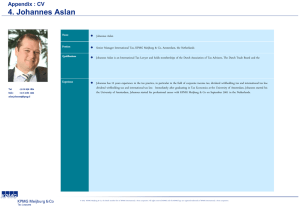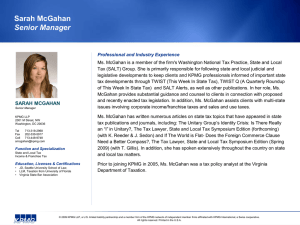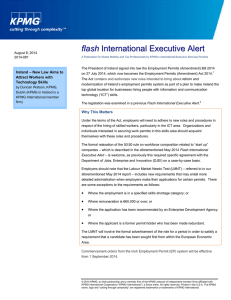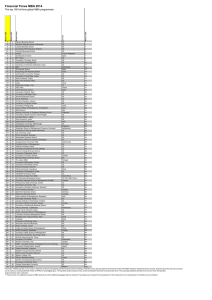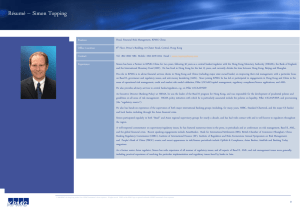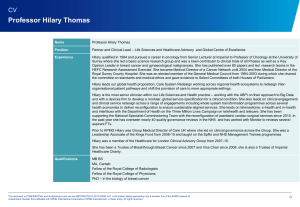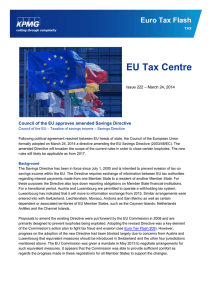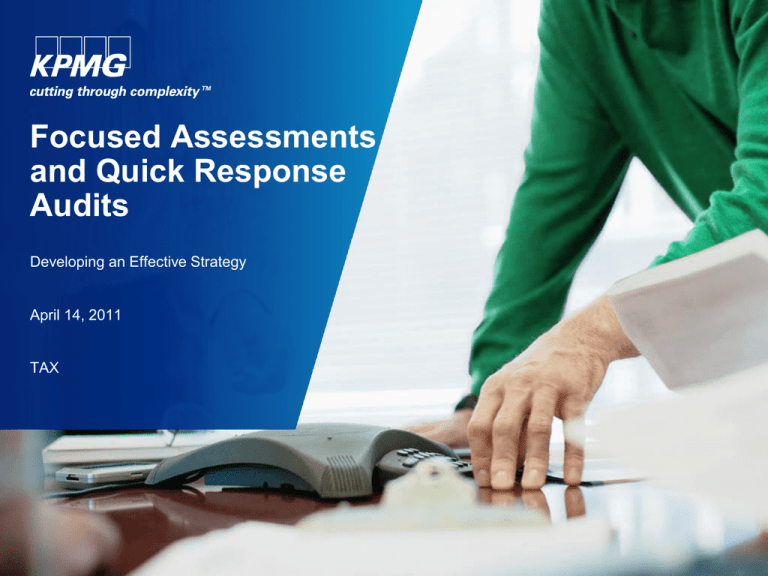
Focused Assessments
and Quick Response
Audits
Developing an Effective Strategy
April 14, 2011
TAX
Any tax advice in this communication is not intended or written by
KPMG to be used, and cannot be used, by a client or any other person or
entity for the purpose of (i) avoiding penalties that may be imposed on
any taxpayer or (ii) promoting, marketing or recommending to another
party any matters addressed herein.
All information provided is of a general nature and is not intended to
address the circumstances of any particular individual or entity.
Although we endeavor to provide accurate and timely information, there
can be no guarantee that such information is accurate as of the date it is
received or that it will continue to be accurate in the future. No one
should act upon such information without appropriate professional
advice after a thorough examination of the particular situation.
© 2011 KPMG LLP, a Delaware limited liability partnership and the U.S. member firm of the KPMG network of
independent member firms affiliated with KPMG International Cooperative (“KPMG International”), a Swiss entity.
All rights reserved. The KPMG name, logo and “cutting through complexity” are registered trademarks or trademarks
of KPMG International.
2
Contents
• What is a Focused Assessment
• What is a Quick Response Audit
• Who is at risk for a US Customs and Border Protection Audit
• Steps in Preparation for a Focused Assessment or Quick Response Audit:
- Information Gathering
• Steps to Ensure Future Compliance:
- Issue Assessment
- Internal Controls
© 2011 KPMG LLP, a Delaware limited liability partnership and the U.S. member firm of the KPMG network of
independent member firms affiliated with KPMG International Cooperative (“KPMG International”), a Swiss entity.
All rights reserved. The KPMG name, logo and “cutting through complexity” are registered trademarks or trademarks
of KPMG International.
3
What is a Focused Assessment
What is a Quick Response Audit
Who is at risk for a US Customs and Border Protection Audit
Steps in Preparation for a Focused Assessment or Quick Response Audit:
Information Gathering
Steps to Insure Future Compliance:
Issue Assessment
Internal Controls
© 2011 KPMG LLP, a Delaware limited liability partnership and the U.S. member firm of the KPMG network of
independent member firms affiliated with KPMG International Cooperative (“KPMG International”), a Swiss entity.
All rights reserved. The KPMG name, logo and “cutting through complexity” are registered trademarks or trademarks
of KPMG International.
4
What is a Focused Assessment
• A risk-based approach to auditing in which US Customs and Border Protection (“CBP”) evaluates a
company’s import related internal controls:
- Identifies areas of risk by evaluating the adequacy of the company’s internal control system
• CBP Focused Assessment Phases:
1.Pre-Assessment Survey (“PAS”)
2.Assessment Compliance Testing
- Transaction testing used to measure compliance/determine loss of revenue
•
CBP may test 1-20 Transactions from Purchase Order to Proof of Payment based upon the
company’s pre-assessment survey
Chart of Accounts Review
3.Follow-up Review
Verification of the Company’s corrective actions if any
© 2011 KPMG LLP, a Delaware limited liability partnership and the U.S. member firm of the KPMG network of
independent member firms affiliated with KPMG International Cooperative (“KPMG International”), a Swiss entity.
All rights reserved. The KPMG name, logo and “cutting through complexity” are registered trademarks or trademarks
of KPMG International.
5
What is a Focused Assessment (cont.)
• CBP’s general areas of emphasis:
- Valuation
- Harmonized Tariff Schedule (“HTS”) Classification
- Anti-Dumping/Countervailing Duties (“ADD/CVD”)
- Transshipment
• Additional review areas:
- Special Trade Programs (ex. NAFTA, GSP)
- Special Duty Provisions (ex. HTS Ch. 98)
- Reconciliation
- Quantity
- Foreign Trade Zone (“FTZ”)
© 2011 KPMG LLP, a Delaware limited liability partnership and the U.S. member firm of the KPMG network of
independent member firms affiliated with KPMG International Cooperative (“KPMG International”), a Swiss entity.
All rights reserved. The KPMG name, logo and “cutting through complexity” are registered trademarks or trademarks
of KPMG International.
6
Chart of Accounts Review - Statutory Additions
© 2011 KPMG LLP, a Delaware limited liability partnership and the U.S. member firm of the KPMG network of
independent member firms affiliated with KPMG International Cooperative (“KPMG International”), a Swiss entity.
All rights reserved. The KPMG name, logo and “cutting through complexity” are registered trademarks or trademarks
of KPMG International.
7
What is a Focused Assessment (cont.)
• If an unacceptable level of risk is determined during the Pre-Assessment Survey, a Company may either:
- Create a Compliance Improvement Plan which entails:
• Actions to be taken;
• Timetable of implementation; and
• Scheduling a follow up review by CBP or
- Proceed directly to the Assessment Compliance Testing (“ACT”)
• In ACT, Customs identifies the extent of compliance and/or computes the loss of revenue for areas of
risk.
- Under the following circumstances, the FA team may have to proceed to the ACT portion of the FA for
review areas determined to have unacceptable risks to Customs.
• Unacceptable risks may be as follows:
• Company does not maintain adequate internal controls to control import related risks
• Revenue issues and additional testing is needed
© 2011 KPMG LLP, a Delaware limited liability partnership and the U.S. member firm of the KPMG network of
independent member firms affiliated with KPMG International Cooperative (“KPMG International”), a Swiss entity.
All rights reserved. The KPMG name, logo and “cutting through complexity” are registered trademarks or trademarks
of KPMG International.
8
What is a Focused Assessment (cont.)
- Upon completion of the Focused Assessment, CBP will issue a report which may consist of the
following:
• Provide suggestions to improve internal controls
• Assess penalties for non-compliant transactions
• Consider appropriate enforcement action
© 2011 KPMG LLP, a Delaware limited liability partnership and the U.S. member firm of the KPMG network of
independent member firms affiliated with KPMG International Cooperative (“KPMG International”), a Swiss entity.
All rights reserved. The KPMG name, logo and “cutting through complexity” are registered trademarks or trademarks
of KPMG International.
TITLE HERE (GO HEADER & FOOTER TO EDIT THIS TEXT)
9
What is a Focused Assessment
What is a Quick Response Audit
Who is at risk for a US Customs and Border Protection Audit
Steps in Preparation for a Focused Assessment or Quick Response Audit:
Information Gathering
Steps to Insure Future Compliance:
Issue Assessment
Internal Controls
© 2011 KPMG LLP, a Delaware limited liability partnership and the U.S. member firm of the KPMG network of
independent member firms affiliated with KPMG International Cooperative (“KPMG International”), a Swiss entity.
All rights reserved. The KPMG name, logo and “cutting through complexity” are registered trademarks or trademarks
of KPMG International.
10
What is a Quick Response Audit
• A Quick Response Audit (“QRA”) is a single-issue audit with narrow focus to address a specific
objective within a short period of time (sometimes)
• The QRA will involve importer’s transactions that have been identified as a potential risk
- QRA’s are not limited to but may range from the following:
• An audit of an importer’s CBP operations
• Determining if there is a potential unlawful shipment/transaction
• Audit of the company’s controls regarding particular laws and/or regulations (i.e. Antidumping,
Special Trade Programs, etc.)
• QRA generally originate from referrals by other CBP and Homeland Security offices
© 2011 KPMG LLP, a Delaware limited liability partnership and the U.S. member firm of the KPMG network of
independent member firms affiliated with KPMG International Cooperative (“KPMG International”), a Swiss entity.
All rights reserved. The KPMG name, logo and “cutting through complexity” are registered trademarks or trademarks
of KPMG International.
11
What is a Quick Response Audit (cont.)
• CBP Quick Response Audit Approach
1.
Request quick response support for review transaction or area
2.
Create objectives for which requested party will need to satisfy
-
3.
The objectives and the scope of the request should be limited in nature
CBP is suppose to issue a report for the current Quick Response Audit
-
Roughly 90 days
-
If non-compliance is determined by CBP, the objectives and scope may widen to a FA
© 2011 KPMG LLP, a Delaware limited liability partnership and the U.S. member firm of the KPMG network of
independent member firms affiliated with KPMG International Cooperative (“KPMG International”), a Swiss entity.
All rights reserved. The KPMG name, logo and “cutting through complexity” are registered trademarks or trademarks
of KPMG International.
12
What is a Focused Assessment
What is a Quick Response Audit
Who is at risk for a US Customs and Border Protection Audit
Steps in Preparation for a Focused Assessment or Quick Response Audit:
Information Gathering
Steps to Insure Future Compliance:
Issue Assessment
Internal Controls
© 2011 KPMG LLP, a Delaware limited liability partnership and the U.S. member firm of the KPMG network of
independent member firms affiliated with KPMG International Cooperative (“KPMG International”), a Swiss entity.
All rights reserved. The KPMG name, logo and “cutting through complexity” are registered trademarks or trademarks
of KPMG International.
13
Who is at Risk for CBP Audits
Compliance
Threat
Priority Trade Issues:
Material
Discrepancies:
•Textiles/Wearing Apparel
•Intellectual Property Rights
•Agriculture
•Revenue
•Penalties
•Anti-Dumping/Countervailing
Duties
•Incorrect HTS
Classifications
•Incorrect Entered Value
Major Accounts
© 2011 KPMG LLP, a Delaware limited liability partnership and the U.S. member firm of the KPMG network of
independent member firms affiliated with KPMG International Cooperative (“KPMG International”), a Swiss entity.
All rights reserved. The KPMG name, logo and “cutting through complexity” are registered trademarks or trademarks
of KPMG International.
14
What is a Focused Assessment
What is a Quick Response Audit
Who is at risk for a US Customs and Border Protection Audit
Steps in Preparation for a Focused Assessment or Quick Response Audit:
Information Gathering
Steps to Insure Future Compliance:
Issue Assessment
Internal Controls
© 2011 KPMG LLP, a Delaware limited liability partnership and the U.S. member firm of the KPMG network of
independent member firms affiliated with KPMG International Cooperative (“KPMG International”), a Swiss entity.
All rights reserved. The KPMG name, logo and “cutting through complexity” are registered trademarks or trademarks
of KPMG International.
15
Initial Steps in Preparation for a Focused Assessment or Quick Response Audit
Information Gathering
• The recommended documentation your company may want to review should include:
- The Company’s existing Customs Compliance Manual
- Any prior disclosures, binding rulings or other written documents submitted to CBP
- Agreements/contracts related to any Customs issues (ex. Sales, royalties, commissions, etc.)
- Previous internal audit or assessment reports generated by the Company
- Any request for information or notices of action (CBP-28 or CBP 29)
• If issues are determined – File a Prior Disclosure to protect from penalties
© 2011 KPMG LLP, a Delaware limited liability partnership and the U.S. member firm of the KPMG network of
independent member firms affiliated with KPMG International Cooperative (“KPMG International”), a Swiss entity.
All rights reserved. The KPMG name, logo and “cutting through complexity” are registered trademarks or trademarks
of KPMG International.
16
What is a Focused Assessment
What is a Quick Response Audit
Who is at risk for a US Customs and Border Protection Audit
Steps in Preparation for a Focused Assessment or Quick Response Audit:
Information Gathering
Steps to Insure Future Compliance:
Issue Assessment
Internal Controls
© 2011 KPMG LLP, a Delaware limited liability partnership and the U.S. member firm of the KPMG network of
independent member firms affiliated with KPMG International Cooperative (“KPMG International”), a Swiss entity.
All rights reserved. The KPMG name, logo and “cutting through complexity” are registered trademarks or trademarks
of KPMG International.
17
Steps to Insure Future Compliance
Issue Assessment
• As part of their internal testing, a Company should test the following areas:
- Record Keeping
• Documentation should be readily available from Purchase Order to Payment including any other
documentation to support what was reported to CBP
- Tariff Classification
- Product Valuation (ex. statuary additions such as assists, commissions and the like)
- Country of Origin Marking
- Merchandise Quantities
- Related Party Transactions
- Special Trade Programs (ex. NAFTA,GSP, etc)
- Internal Controls
© 2011 KPMG LLP, a Delaware limited liability partnership and the U.S. member firm of the KPMG network of
independent member firms affiliated with KPMG International Cooperative (“KPMG International”), a Swiss entity.
All rights reserved. The KPMG name, logo and “cutting through complexity” are registered trademarks or trademarks
of KPMG International.
18
What is a Focused Assessment
What is a Quick Response Audit
Who is at risk for a US Customs and Border Protection Audit
Steps in Preparation for a Focused Assessment or Quick Response Audit:
Information Gathering
Steps to Insure Future Compliance:
Issue Assessment
Internal Controls
© 2011 KPMG LLP, a Delaware limited liability partnership and the U.S. member firm of the KPMG network of
independent member firms affiliated with KPMG International Cooperative (“KPMG International”), a Swiss entity.
All rights reserved. The KPMG name, logo and “cutting through complexity” are registered trademarks or trademarks
of KPMG International.
19
Steps to Ensure Future Compliance
Internal Controls
• Establish awareness throughout the organization of the importance of customs compliance
• Implementation of policies, procedures, techniques, for all areas that touch customs
• Formulate qualitative and quantitative methods for monitoring compliance in key check areas (ex.
classification, valuation, quantity, country of origin and record keeping).
• Develop controls to monitor compliance arising from both internal and external factors
• Ensure that an effective information and communication process is in place between departments. Typical
departments which may have customs implications Accounting, Purchasing, Receiving
• Perform ongoing monitoring to ensure internal controls are working. Monthly, Quarterly or Annual testing.
Important: Make sure your testing is documented as CBP will request it for support
Great internal controls = Less Risk!
© 2011 KPMG LLP, a Delaware limited liability partnership and the U.S. member firm of the KPMG network of
independent member firms affiliated with KPMG International Cooperative (“KPMG International”), a Swiss entity.
All rights reserved. The KPMG name, logo and “cutting through complexity” are registered trademarks or trademarks
of KPMG International.
20
Thank you
Contact:
Mike Vitale
KPMG LLP
(631) 425 6694
mvitale@kpmg.com
www.kpmg.com
© 2011 KPMG LLP, a Delaware limited liability partnership and the U.S. member firm of the KPMG
network of independent member firms affiliated with KPMG International Cooperative
(“KPMG International”), a Swiss entity. All rights reserved. 43427CHI
The information contained herein is of a general nature and is not intended to address
the circumstances of any particular individual or entity. Although we endeavour to provide
accurate and timely information, there can be no guarantee that such information is accurate
as of the date it is received or that it will continue to be accurate in the future. No one should
act on such information without appropriate professional advice after a thorough examination
of the particular situation.


